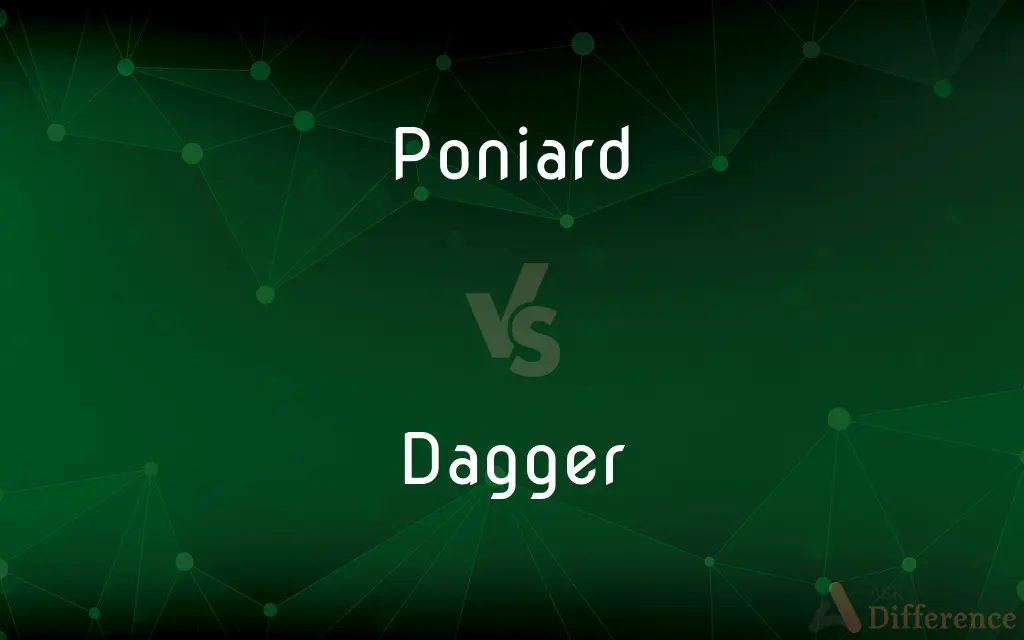Poniard vs. Dagger — What's the Difference?
By Fiza Rafique & Urooj Arif — Updated on March 12, 2024
A poniard is a slim, pointed stabbing weapon, ideal for precise thrusts, whereas a dagger is a double-edged blade for both stabbing and slashing.

Difference Between Poniard and Dagger
Table of Contents
ADVERTISEMENT
Key Differences
Poniards are specifically designed for stabbing with a narrow, pointed blade, making them ideal for precise, deep thrusts. Daggers, on the other hand, feature a double-edged blade that can be used not only for stabbing but also for slashing, providing a more versatile option in combat or self-defense situations.
Historically, poniards have been used as secondary weapons or for concealed carry, due to their slim profile and ease of concealment. Daggers, meanwhile, have been employed across various cultures and periods as both primary and secondary weapons, reflecting their adaptability and effectiveness in a wide range of scenarios.
In terms of construction, poniards often have a more delicate and refined build, with some featuring ornate designs that signify status or affiliation. Daggers, while they can also be decorative, are generally more robust and utilitarian in design, prioritizing function over form.
The technique required to wield a poniard effectively is specialized, focusing on precision and the ability to exploit vulnerabilities in an opponent's defense. Daggers, conversely, allow for a broader range of fighting techniques, including slashing and parrying, making them suitable for a variety of combat styles.
In literature and historical texts, poniards are frequently associated with clandestine activities, such as assassinations or duels, emphasizing their role as weapons of subtlety and surprise. Daggers have a broader representation, symbolizing courage, betrayal, or power, depending on the context, which underscores their versatility and symbolic significance.
ADVERTISEMENT
Comparison Chart
Blade Type
Slim, pointed for stabbing
Double-edged for stabbing and slashing
Usage
Precision thrusting, concealment
Versatile combat, including slashing
Design
Often delicate and ornate
Robust and utilitarian
Technique
Precision and exploitation of vulnerabilities
Broad range including slashing and parrying
Symbolism
Clandestine activities, subtlety
Courage, betrayal, power
Compare with Definitions
Poniard
A slim, pointed stabbing weapon, often used for precise, deep thrusts.
The assassin concealed a poniard within his cloak, its blade glinting in the moonlight.
Dagger
A short, double-edged blade used for stabbing and slashing.
The warrior's dagger was both a utility tool and a lethal weapon.
Poniard
Features a narrow blade, optimizing it for piercing.
The poniard's narrow blade made it the perfect tool for a silent attack.
Dagger
Can symbolize betrayal or power in literature.
The dagger, hidden beneath his cloak, was a silent witness to the impending betrayal.
Poniard
Historically associated with nobility and clandestine acts.
The nobleman's poniard was as much a symbol of his status as it was a weapon.
Dagger
Versatile in combat and personal defense.
With her dagger in hand, she was ready for whatever danger lay ahead.
Poniard
Designed for concealment and surprise attacks.
She deftly used her poniard to defend herself, catching her attacker off guard.
Dagger
Utilized across various cultures and periods.
The museum's collection featured daggers from civilizations around the world.
Poniard
Symbolizes subtlety and precision in historical texts.
In the tale, the hero's poniard was a testament to his cunning and precision.
Dagger
A dagger is a knife with a very sharp point and usually two sharp edges, typically designed or capable of being used as a thrusting or stabbing weapon. Daggers have been used throughout human history for close combat confrontations, and many cultures have used adorned daggers in ritual and ceremonial contexts.
Poniard
A small, slim dagger.
Dagger
A short knife with a pointed and edged blade, used as a weapon
He drew his dagger and stabbed the leader
Poniard
A dagger typically having a slender three- or four-sided blade.
Dagger
A moth with a dark dagger-shaped marking on the forewing.
Poniard
To stab with such a dagger.
Dagger
A short pointed weapon with sharp edges.
Poniard
A dagger typically having a slender square or triangular blade.
Dagger
Something that agonizes, torments, or wounds.
Poniard
To stab with a poniard.
Dagger
See obelisk.
Poniard
A kind of dagger, - usually a slender one with a triangular or square blade.
She speaks poniards, and every word stabs.
Dagger
A double dagger.
Poniard
To pierce with a poniard; to stab.
Dagger
(weapons) A stabbing weapon, similar to a sword but with a short, double-edged blade.
Poniard
A dagger with a slender blade
Dagger
(typography) The text character †; the obelus.
Poniard
Stab with a poniard
Dagger
A point scored near the end of the game (clutch time) to take or increase the scorer's team lead, so that they are likely to win.
Curry's last-minute 3-point dagger silenced the criticism for his so-called failure to come up big in big moments.
Dagger
A timber placed diagonally in a ship's frame.
Dagger
To pierce with a dagger; to stab.
Dagger
A short weapon used for stabbing. This is the general term: cf. Poniard, Stiletto, Bowie knife, Dirk, Misericorde, Anlace.
Dagger
A mark of reference in the form of a dagger [
Dagger
A timber placed diagonally in a ship's frame.
Dagger
To pierce with a dagger; to stab.
Dagger
A short knife with a pointed blade used for piercing or stabbing
Dagger
A character used in printing to indicate a cross reference or footnote
Common Curiosities
What is the main use of a poniard?
A poniard is primarily used for stabbing, focusing on precision and depth of penetration.
Can poniards be used for slashing?
Poniards are not designed for slashing, given their narrow, pointed blades focused on stabbing.
What materials are used to make poniards and daggers?
Both are typically made from metal, but the handle materials can vary from wood and bone to precious metals and stones for decoration.
Why might someone choose a poniard over a dagger?
Someone might choose a poniard for tasks requiring precise stabbing or for easier concealment due to its slim profile.
How are poniards and daggers different in design?
Poniards are typically slimmer and may have more ornate designs, while daggers are more robust and utilitarian.
Can a dagger be used for slashing?
Yes, a dagger's double-edged blade allows for both stabbing and slashing actions.
Were poniards ever used as primary weapons?
Poniards were generally secondary weapons or tools for self-defense, not typically primary weapons in combat.
Do daggers have any ceremonial use?
Yes, daggers are often used in ceremonial contexts, such as knighthoods or traditional rituals.
Are daggers still used today?
While not common in modern combat, daggers are still used in ceremonial contexts and collected as historical or decorative items.
What is the historical significance of daggers?
Daggers have been significant in various cultures as weapons of war, symbols of power, and tools of utility.
How do the techniques for wielding a poniard differ from those for a dagger?
Poniard techniques focus on precision stabbing, while dagger techniques allow for a broader range of movements including slashing.
Can poniards and daggers be considered art?
Yes, many poniards and daggers are considered art pieces, especially those with intricate designs and historical significance.
What type of fighting style is associated with daggers?
Dagger fighting styles include close combat techniques, emphasizing agility and the ability to strike at vital points.
What role do poniards and daggers play in literature?
They are often symbolic, representing themes of betrayal, power, or the personal nature of combat.
Are there any famous historical figures known for using a poniard or dagger?
Yes, figures such as Julius Caesar and Renaissance duelists are associated with the use of daggers or poniards.
Share Your Discovery

Previous Comparison
Prolific vs. Proliferous
Next Comparison
Mocha vs. ChocolateAuthor Spotlight
Written by
Fiza RafiqueFiza Rafique is a skilled content writer at AskDifference.com, where she meticulously refines and enhances written pieces. Drawing from her vast editorial expertise, Fiza ensures clarity, accuracy, and precision in every article. Passionate about language, she continually seeks to elevate the quality of content for readers worldwide.
Co-written by
Urooj ArifUrooj is a skilled content writer at Ask Difference, known for her exceptional ability to simplify complex topics into engaging and informative content. With a passion for research and a flair for clear, concise writing, she consistently delivers articles that resonate with our diverse audience.














































